Digital Posters
Lung: Disease Assessment
ISMRM & SMRT Annual Meeting • 15-20 May 2021

| Concurrent 5 | 17:00 - 18:00 |
3205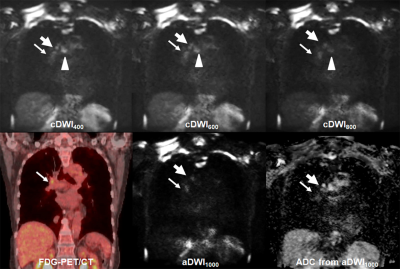 |
Computed DWIs with different b values vs. Actual DWI vs. FDG-PET/CT: Capability for N-Stage Assessment in NSCLC Patients. Video Permission Withheld
Yoshiharu Ohno1,2,3, Masao Yui4, Takeshi Yoshikawa3,5, Daisuke Takenaka5, Kaori Yamamoto4, Yoshimori Kassai4, Kazuhiro Murayama2, and Hiroshi Toyama1
1Radiology, Fujita Health University School of Medicine, Toyoake, Japan, 2Joint Research Laboratory of Advanced Medical Imaging, Fujita Health University School of Medicine, Toyoake, Japan, 3Division of Functional and Diagnostic Imaging Research, Department of Radiology, Kobe University Graduate School of Medicine, Kobe, Japan, 4Canon Medical Systems Corporation, Otawara, Japan, 5Diagnostic Radiology, Hyogo Cancer Center, Akashi, Japan
No major papers that directly compared the capability for N-stage evaluation among cDWIs with different b values, aDWI and FDG-PET/CT in NSCLC patients. We hypothesize that cDWI has a potential for improving diagnostic performance of N-stage in NSCLC patients as compared with aDWI as well as FDG-PET/CT, when set appropriate b value. The purpose of this study is to directly compare the capability for N-stage evaluation among cDWI with different b values, aDWI and FDG-PET/CT in NSCLC patients.
|
|||
3206.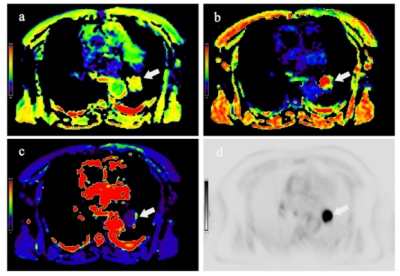 |
The value of PET/MRI in the identification of non-small cell lung cancer: stretch index diffusion imaging and metabolic parameters
Zhun Huang1, Nan Meng2, Zhixue Wang3, Fangfang Fu2, Pengyang Feng1, Ting Fang2, Yan Bai2, Wei Wei2, Yaping Wu2, Jianmin Yuan4, Yang Yang5, Hui Liu6, and Meiyun Wang*1
1Department of Radiology, Henan University People’s Hospital & Henan Provincial People’s Hospital, School of Basic Medicine, zhengzhou, China, 2Department of Radiology, Zhengzhou University People’s Hospital & Henan Provincial People’s Hospital, Academy of Medical Sciences, zhengzhou, China, 3Department of Radiology, the First Affiliated Hospital of Henan Medical University, Kai Feng, China, 4Central Research Institute, UIH Group, Shanghai, China, zhengzhou, China, 5Central Research Institute, UIH Group, Beijing, China, Bei Jing, China, 6UIH America, Inc, Houston, TX, United States, Houston, TX, United States
PET/MRI is a very promising technology. PET can reflect metabolism, and stretch index diffusion imaging can reflect molecular diffusion rate and heterogeneity. The results show that the combination of the two has the best identification effect, and further analysis shows that SUVmax is negatively correlated with α.
|
|||
3207.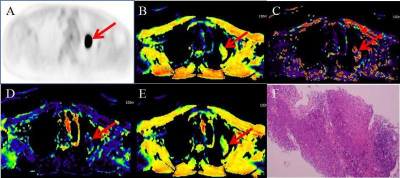 |
Distinguishing malignant and benign lung lesions with multiparametric 18F-FDG PET/MRI: Comparison of metabolic parameters and IVIM parameters
Fangfang Fu1, Nan Meng2, Zhun Huang3, Yaping Wu1, Pengyang Feng3, Xiaochen Li1, Yan Bai1, Wei Wei1, Jianmin Yuan4, Tianyi Xu4, and Meiyun Wang1
1Department of Medical Imaging, Henan Provincial People’s Hospital, People’s Hospital of Zhengzhou University, Zhengzhou, China, 2Department of Radiology, Zhengzhou University People’s Hospital & Henan Provincial People’s Hospital, Academy of Medical Sciences, Zhengzhou, China, 3Department of Radiology, Henan University People’s Hospital & Henan Provincial People’s Hospital, School of Basic Medicine. Department of Radiology, Zhengzhou University People’s Hospital & Henan Provincial People’s Hospital, Academy of Medical Sciences., Zhengzhou, China, 42258 Chengbei Road, Jiading District, Shanghai, China 201907, Shanghai, China
Distinguishing malignant from benign pulmonary lesions is critical. In the study, 18F-FDG PET/MRI were used to obtain metabolic parameters and IVIM diffusion parameters for differential diagnosis of benign and malignant lung lesions. Our results showed that multiparametric PET/MRI is helpful in the differentiation of pulmonary lesions. 18 FDG hybrid PET-MRI enables a robust differentiation of malignant and benign pulmonary lesions when several IVIM parameters and PET parameters are combined. Thus, PET-MRI may reduce some unnecessary lung biopsies.
|
|||
3208.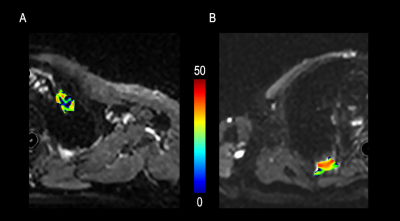 |
Pulmonary functional imaging for lung adenocarcinoma: combined MRI assessment based on IVIM-DWI and OE-UTE-MRI
Gaofeng Shi1, Liyun Zheng2, Yongming Dai2, Hui Liu1, Hui Feng1, and Hongshan Zhu1
1Department of Radiology, Fourth Hospital of Hebei Medical University, Shijiazhuang, China, 2United Imaging Healthcare, Shanghai, China
Despite the introduction of new treatment options in recent years, the survival rates of patients with lung adenocarcinoma (LUAD) remain unsatisfactory. In order to care for patients effectively, clear insight into the processes of ventilation and perfusion of LUAD is required. In this work, Intravoxel incoherent motion diffusion weighted imaging (IVIM-DWI) was used to monitor the blood flow while oxygen-enhanced MRI (OE-MRI) was used to measure the ventilation. Our results showed that the combined measurement of OE-MRI and IVIM-DWI may serve as a promising method for the noninvasive assessment of lung function and classification of LUAD subtype.
|
|||
3209.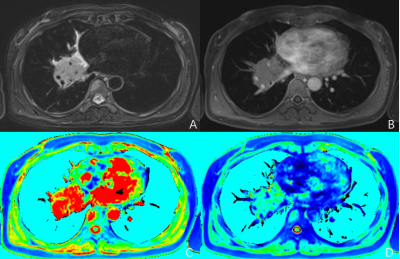 |
The diagnostic value of MRI extracellular volume(ECV) to pulmonary occupied lesions
Yongqing Yang1,2, Peng Zhao2, Xiangtao Lin1,2, Yu Wang1,2, Mengxiao Liu3, Wenjing Ma2, Shuai Duan2, Nan Lin2, Xiaoli Li1,2, Dejuan Shan1,2, and Zhongyu Hou2
1Radiology, Shandong Provincial Hospital Affiliated to Shandong University, Jinan, China, 2Radiology, Shandong Provincial Hospital Affiliated to Shandong First Medical University, Jinan, China, 3MR Scientific Marketing,Diagnostic Imaging, Siemens Healthcare Ltd., Shanghai, China
In order to diagnose of the pathological type of pulmonary occupied lesions by non-invasive imaging, 30 patients were scanned with chest MRI using Siemens 3T scanner. The T1 mapping sequences were used before and after the injection of contrast agent, and the extracellular volume (ECV) was calculated. The statistical differences of ECV between squamous, adenocarcinoma and small cell carcinoma were analyzed by single-factor variance, and there were significant statistical differences (P<0.05).
|
|||
3210.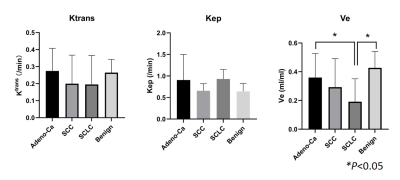 |
Using GRASP-DCE MRI for the Identification of Subtypes of Lung Cancers from Benign Lung Lesions.
Dandan Peng1, Cong Xia1, Yuancheng Wang1, Zhongshuai Zhang2, and Shenghong Ju1
1Zhongda Hospital, Medical School of Southeast University, Nanjing, China, 2SIEMENS Healcare, Shanghai, China
This study is expected to provide information about differentiating of benign from malignant pulmonary lesions with free-breathing Golden-angle RAdial Sparse Parallel (GRASP)-DCE MRI among 33 lung lesions. The results initially indicated that the quantitative DCE parameter maps calculated by GRASP-DCE MR could be a clinical useful technique for lung lesions detection.
|
|||
3211.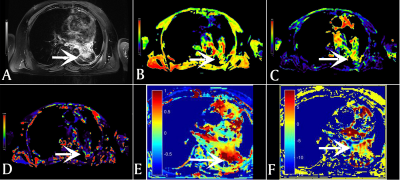 |
Analysis of the diagnostic value of multimodal magnetic resonance imaging for non-small cell lung cancer
Ting Fang1, Nan Meng1, Meiyun Wang1,2, Zhun Huang2, Pengyang Feng2, Fangfang Fu3, Wei Wei3, Yaping Wu3, Yan Bai3, Jianmin Yuan4, Yang Yang5, and Hui Liu 6
1Department of Radiology, Zhengzhou University People’s Hospital & Henan Provincial People’s Hospital, Zhengzhou, China, 2Department of Radiology, Henan University People’s Hospital & Henan Provincial People’s Hospital, Zhengzhou, China, 3Henan Provincial People’s Hospital, Zhengzhou, China, 4Central Research Institute, UIH Group, Shanghai, China, 5Central Research Institute, UIH Group, Beijing, China, 6UIH America, Inc. 9230 Kirby Dr. STE600, Houston, TX, United States
Chemical exchange saturation transfer (CEST) is a new type of MRI technology, can selectively label the exchangeable hydrogen protons in endogenous or exogenous free macromolecules. Intravoxel incoherent motion (IVIM) MRI can be separated to obtain information related to true water molecule diffusion and microcirculation perfusion through double exponential model analysis. Our research shows that CEST and IVIM have similar diagnostic performance in the differential diagnosis of lung squamous cell carcinoma and lung adenocarcinoma.
|
|||
3212.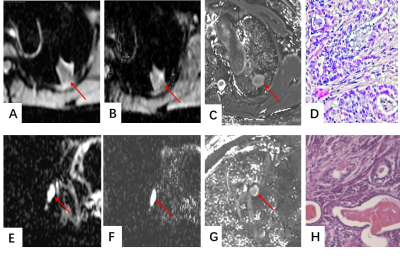 |
Differentiation of malignant and benign solitary pulmonary nodules using radial sampled T2 mapping and DW-IVIM with reduced FOV
Fu Yicheng1, Zhang Zhongshuai2, Yu Ye1, and Wu Huawei1
1Radiology, Renji Hospital, School of Medicine, Shanghai Jiaotong University, Shanghai, China, 2SIEMENS Healthcare, China, Shanghai, China
We use quantitative parameters of T2 mapping and diffusion-weighted intro-voxel incoherent movement (DW-IVIM) with reduced field of view to distinguishing different type of solitary pulmonary nodules. Our result is the 90%, maximum of T2 value, ADC value, mean and maximum of D value had significant difference between benign and malignant SPNs which mean quantitative T2 mapping and IVIM parameters may provide valuable information and serve as a supplementary imaging marker for differentiating malignant from benign SPNs.
|
|||
3213. |
Comparing ADC and IVIM for Identification of the subtypes of Lung Cancers from Benign Lung Lesions using iShim technique
Dandan Peng1, Zhongshuai Zhang2, Cong Xia1, Yuancheng Wang1, and Shenghong Ju1
1Zhongda Hospital, Medical School of Southeast University, Nanjing, China, 2SIEMENS Healcare, Shanghai, China
This study aimed to provide information about differentiation of benign from malignant pulmonary lesions with Intravoxel Incoherent Motion Diffusion-Weighted using individual shimming technique among 33 lung lesions. The results initially indicated that ADC and IVIM and could be great techniques for lung lesions detection.
|
|||
3214.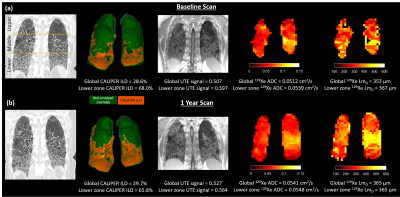 |
Comparison of UTE 1H lung MRI with quantitative CT and hyperpolarized 129Xe diffusion-weighted MRI in IPF
Ho-Fung Chan1, James A Eaden1, Nicholas D Weatherley1, Kevin Johnson2, Guilhem J Collier1, Madhwesha Rao1, Graham Norquay1, Jody Bray1, Smitha Rajaram1, Andrew J Swift1, Ronald A Karwoski3, Brian J Bartholmai3, Stephen M Bianchi4,
and Jim M Wild1
1Infection, Immunity and Cardiovascular Disease, University of Sheffield, Sheffield, United Kingdom, 2Radiology and Medical Physics, University of Wisconsin, Madison, WI, United States, 3Biomedical Imaging Resource, Mayo Clinic, Rochester, MN, United States, 4Academic Directorate of Respiratory Medicine, Sheffield Teaching Hospitals NHS Foundation Trust, Sheffield, United Kingdom
A simple signal density-based analysis of UTE 1H MRI was compared to hyperpolarized 129Xe diffusion-weighted (DW)-MRI and CALIPER CT in twelve idiopathic pulmonary fibrosis (IPF) patients at baseline and after 1 year. A statistically significant correlation between the normalized UTE signal and CALIPER interstitial lung disease percentage was observed in the lower lung zone. Trends between UTE signal and 129Xe DW-MRI metrics in the lower zone was observed, and no significant longitudinal change in UTE MRI signal was observed. UTE MRI signal is sensitive to IPF lung parenchyma changes and may demonstrate sensitivity to longitudinal changes in a larger cohort.
|
|||
3215. |
The diagnostic value of MR dynamic enhancement quantitative parameter for usual interstitial pneumonia and nonspecific interstitial pneumonia
XinHui Chen1, ZhiPeng Zhou2, Cheng Ge2, XinGuan Yang2, Long Qian3, and Weiyin Vivian Liu3
1Radiology, Doctor, Zhan Jiang, China, 2doctor, Gui Lin, China, 3MR Research, Beijing, China
Different treatments were not given to patients [1]HRCT on diagnosis of atypical interstitial pneumonia appears to be powerless, so further examination of pathological biopsy is usually required. However, pathological biopsy often causes a series of complications and reduces the survival rate of patients[2]. This study aims to distinguish between UIP and NSIP using MRI dynamic enhancement quantitative parameters. The results showed that the blood flow in the lungs of UIP patients is significantly reduced. The quantitative parameters of MRI dynamic enhancement had potential in distinguishing UIP from NSIP.
|
|||
3216.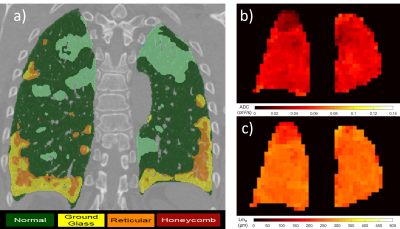 |
Correlation of global and regional hyperpolarised 129-Xenon MRI with quantitative CT in patients with idiopathic pulmonary fibrosis
James A Eaden1,2, Guilhem J Collier1, Ho-Fung Chan1, Nicholas D Weatherley1,2, Graham Norquay1, Smitha Rajaram3, Andy Swift1,3, Ronald A Karwoski4, Brian Bartholmai4, Stephen M Bianchi2, and Jim M Wild1,5
1POLARIS, MRI unit, Department of Infection Immunity and Cardiovascular Disease, University of Sheffield, Sheffield, United Kingdom, 2Academic Directorate of Respiratory Medicine, Sheffield Teaching Hospitals NHS Foundation Trust, Sheffield, United Kingdom, 3Sheffield Teaching Hospitals NHS Foundation Trust, Sheffield, United Kingdom, 4Mayo Clinic, Rochester, MN, United States, 5Insigneo institute, University of Sheffield, Sheffield, United Kingdom
Correlations between 129Xe MRI measures of microstructure and gas exchange and CALIPER CT variables were evaluated both globally and regionally in IPF patients. To date, 27 subjects have undergone both baseline 129Xe DW-MRI and CT with 13 of them having baseline dissolved 129Xe imaging using a 3D radial spectroscopic method. Our findings demonstrate several significant correlations between dissolved 129Xe MRI (RBC:TP, TP:Gas, RBC:Gas) and CALIPER variables. Vessel related structures % was the only CALIPER variable that showed a significant correlation between 129Xe RBC:TP globally and in all lung zones. There were no significant correlations between 129Xe DW-MRI and CALIPER variables.
|
|||
3217.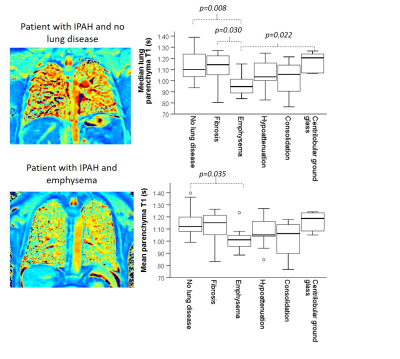 |
Lung parenchyma T1 mapping correlates lung pathology seen on CT in patients with pulmonary hypertension.
Laura Saunders1, Dave Capener1, David G Kiely1,2, Andy J Swift1, and Jim M Wild1
1Infection Immunity and Cardiovascular Disease, University of Sheffield, Sheffield, United Kingdom, 2Sheffield Pulmonary Vascular Disease Unit, Sheffield, United Kingdom
Assessment of lung changes in patients with pulmonary hypertension plays an important role in establishing patient aetiology and treatment. 82 patients with suspected pulmonary hypertension underwent 2D single slice Look-Locker inversion recovery T1 mapping. Lung T1 was significantly lower in patients with emphysema seen on 3D CT than in patients with fibrosis, centrilobular ground glass or no lung disease seen on 3D CT. Lung T1 was more sensitive in differentiating lung pathology seen on CT when excluding lung vessels from average metrics, and when using median rather than mean lung T1.
|
|||
3218.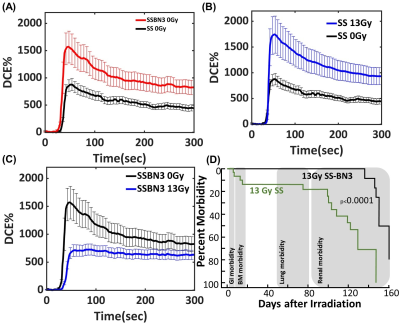 |
Imaging the interplay of notch-DLL4 expression with pulmonary radiation injury using dynamic contrast enhanced ultrashort echo time imaging
El-Sayed H Ibrahim1, Abdul Parchur1, Brian Fish1, Meetha Medhora1, and Amit Joshi1
1Medical College of Wisconsin, Milwaukee, WI, United States
Lung injury after exposure to high-dose radiation during cancer treatment has been well described. Our goal in this study is to develop minimally invasive biomarkers for predicting radiation-induced lung injury and assess the role of DLL4 expression in response to radiation injury. We presented a non-invasive UTE-based DCE MRI method for in-vivo quantification of irradiation-induced vascular perfusion and permeability early changes in lungs using two rat models which only differ in 3rd chromosome and DLL4 expression on endothelium. Such knowledge is crucial for accurately evaluating the efficacy of radioprotectors and therapeutic agents, and for monitoring individuals with survivable radiation injury.
|
|||
3219.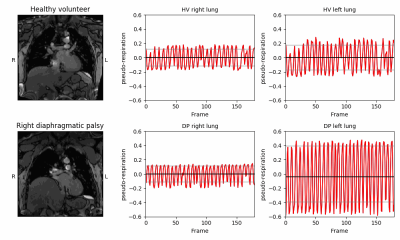 |
Assessment of dynamic thoracic motion for pre and post-surgical assessment using xt-PCA
Laurence H. Jackson1, Joanna Bell2, Giulia Benedetti2, Sze Mun Mak2, Rachael Franklin3, Rebecca Preston2, Andrea Bille4, John Spence2, and Geoff Charles-Edwards1
1Medical Physics, Guy's and St Thomas' NHS Foundation Trust, London, United Kingdom, 2Department of Radiology, Guy's and St Thomas' NHS Foundation Trust, London, United Kingdom, 3Medical Physics, King's College Hospital NHS Foundation Trust, London, United Kingdom, 4Department of Thoracic Surgery, Guy's and St Thomas' NHS Foundation Trust, London, United Kingdom
Despite recent advances in surgical techniques, postoperative complications arise in 24-41% of patients undergoing thoracic surgery. Here we present an MRI protocol for the pre and postoperative assessment of chest wall and diaphragmatic motion which provides valuable dynamic information to aid radiological assessment in these highly variable patients. We also propose a novel method for fully automated extraction of the diaphragm motion which can provide an additional tool to aid radiologists in making the distinction between expected and adverse postoperative pathologies.
|
|||
3220.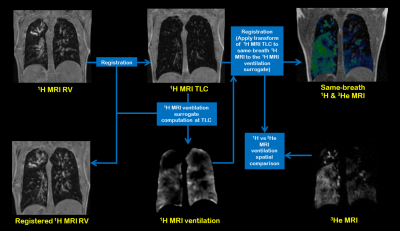 |
Proton lung ventilation MRI in cystic fibrosis: comparison with hyperpolarized gas MRI, pulmonary function tests and multiple-breath washout
Bilal A Tahir1,2, Laurie J Smith1, Joshua R Astley1,2, Michael Walker1, Alberto M Biancardi1, Guilhem J Collier1, Paul J Hughes1, Helen Marshall1, and Jim M Wild1
1POLARIS, University of Sheffield, Sheffield, United Kingdom, 2Oncology and Metabolism, University of Sheffield, Sheffield, United Kingdom
Several methods of mapping regional ventilation from multi-inflation 1H-MRI have been proposed, potentially transforming 1H-MRI from a structural modality into one that can image and quantify pulmonary ventilation. However, their physiological accuracy and sensitivity to lung inflation level is an ongoing research question. Here, we compare surrogates of regional ventilation, derived from non-contrast inspiratory and expiratory breath-hold 3D gradient-echo 1H-MRI with hyperpolarized 3He-MRI, pulmonary functions tests and multiple-breath washout in a cohort of cystic fibrosis patients with a range of disease severity and age. We observed moderate to strong correlations with all lung function measures and 3He-MRI.
|
|||
3221.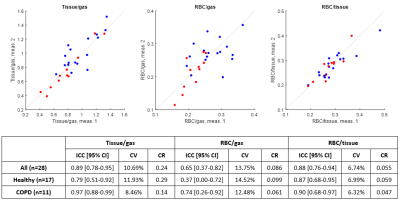 |
Same-session Repeatability of Hyperpolarized 129Xe MRI Gas Uptake Measures in Healthy Subjects and Subjects with COPD
William J Garrison1, G Wilson Miller1,2, Kun Qing2, Y Michael Shim3, Jaime F Mata2, Mu He3, Talissa A Altes4, Joanne M Cassani4, Sarah E Struchen2, Roselove N Nunoo-Asare2, Nicholas J Tustison2, Alan M Ropp2, and John P Mugler III1,2
1Biomedical Engineering, University of Virginia, Charlottesville, VA, United States, 2Radiology and Medical Imaging, University of Virginia, Charlottesville, VA, United States, 3Medicine, University of Virginia, Charlottesville, VA, United States, 4Radiology, University of Missouri, Columbia, MO, United States
Same-session repeatability of quantitative measures of gas uptake derived from MRI of inhaled hyperpolarized 129Xe was assessed in healthy and COPD subjects, as well as the impact of scan-to-scan lung volume differences on measured gas uptake. Strong tissue-to-gas and RBC-to-tissue repeatability was found in same-day dissolved-phase 129Xe MRI scans performed at one-third of forced vital capacity, and regressing out scan-to-scan lung volume changes improved repeatability further. COPD subjects displayed similar or better repeatability when compared with healthy subjects.
|
|||
3222. |
Accelerated dynamic 19F-MRI of inhaled perfluoropropane for quantitative regional assessment of gas wash-in biomarkers in patients with COPD
Mary A. Neal1,2, Benjamin J. Pippard1,2, Kieren G. Hollingsworth1,2, A. John Simpson2, and Peter E. Thelwall1,2
1Newcastle Magnetic Resonance Centre, Newcastle University, Newcastle upon Tyne, United Kingdom, 2Translational and Clinical Research Institute, Newcastle University, Newcastle upon Tyne, United Kingdom
19F-MRI of inhaled perfluoropropane (PFP) permits regional assessment of pulmonary ventilation. Dynamic multi-breath PFP wash-in and wash-out images were acquired in one healthy volunteer and two patients with chronic obstructive pulmonary disease (COPD) during short successive breath holds, using a repeated 3D 19F-SPGR sequence accelerated with compressed sensing. Resultant image quality achieved in each 7.5s compressed sensing acquisition dynamic was sufficient for segmentation and permitted visualisation of a case of gas trapping secondary to apical predominant emphysema. A strong negative correlation between regional wash-in and wash-out rates and spirometric indices was measured.
|
|||
3223.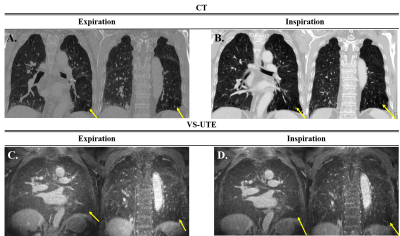 |
Identification of COPD Lesions Using 3D Ultrashort Echo-Time Imaging with Ventilation Map and Ventilation Flow Map
Seokwon Lee1, Jinil Park2, Hyonha Kim1, Ho Yun Lee3, and Jang-Yeon Park1,4
1Department of Biomedical Engineering, Sungkyunkwan University, Suwon, Korea, Republic of, 2Biomedical Institute for Convergence at SKKU, Sungkyunkwan University, Suwon, Korea, Republic of, 3Department of Radiology and Center for Imaging Science, Samsung Medical Center, Seoul, Korea, Republic of, 4Department of Intelligent Precision Healthcare Convergence, Sungkyunkwan University, Suwon, Korea, Republic of
Chronical Obstructive Pulmonary Disease (COPD) is an obstructive lung disease and mainly consists of emphysema and chronic bronchitis. Recent works proposed for the quantitative evaluation of emphysema severity based on the signal intensity of UTE lung images. Through this study, MRI, as well as CT, can represent the defect region for the ventilation defect region, and furthermore, the degree of the lesion and the ventilation function of the lungs can be evaluated such as ventilation map, ventilation flow map and histogram. The potential of methods was validated by ventilation map, ventilation flow map and ventilation histogram in emphysema patient.
|
|||
3224.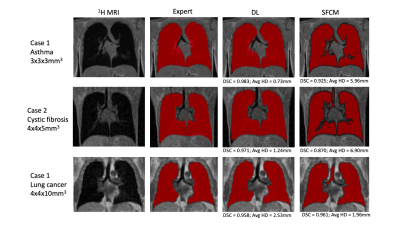 |
Generalizable deep learning for multi-resolution proton MRI lung segmentation in multiple diseases
Joshua R Astley1,2, Alberto M Biancardi1, Helen Marshall1, Laurie J Smith1, Guilhem J Collier1, Paul J Hughes1, Michael Walker1, Matthew Q Hatton2, Jim M Wild1, and Bilal A Tahir1,2
1POLARIS, University of Sheffield, Sheffield, United Kingdom, 2Oncology and Metabolism, University of Sheffield, Sheffield, United Kingdom
We evaluate a fully-automated generalizable deep learning (DL) approach for lung segmentation using a 3D convolutional neural network on a large and diverse proton (1H) MRI dataset, containing images acquired at different resolutions and inflation levels. The dataset comprised of 336 1H-MR images from healthy subjects and patients with respiratory diseases. Our trained model was able to accurately segment scans of markedly different resolutions (3x3x3mm3, 4x4x5mm3 and 4x4x10mm3), achieving a mean±SD Dice similarity coefficient of 0.94±0.02. In addition, it was shown that DL generates more accurate segmentations compared to state-of-the-art solutions.
|
The International Society for Magnetic Resonance in Medicine is accredited by the Accreditation Council for Continuing Medical Education to provide continuing medical education for physicians.